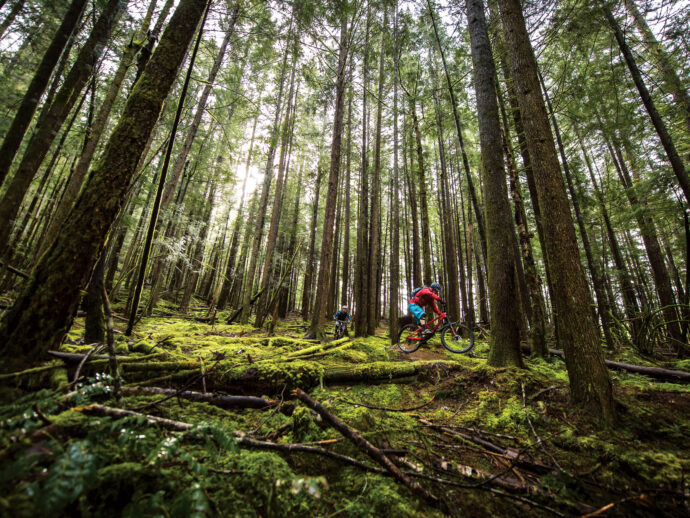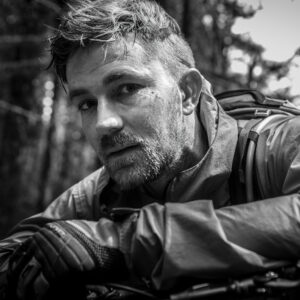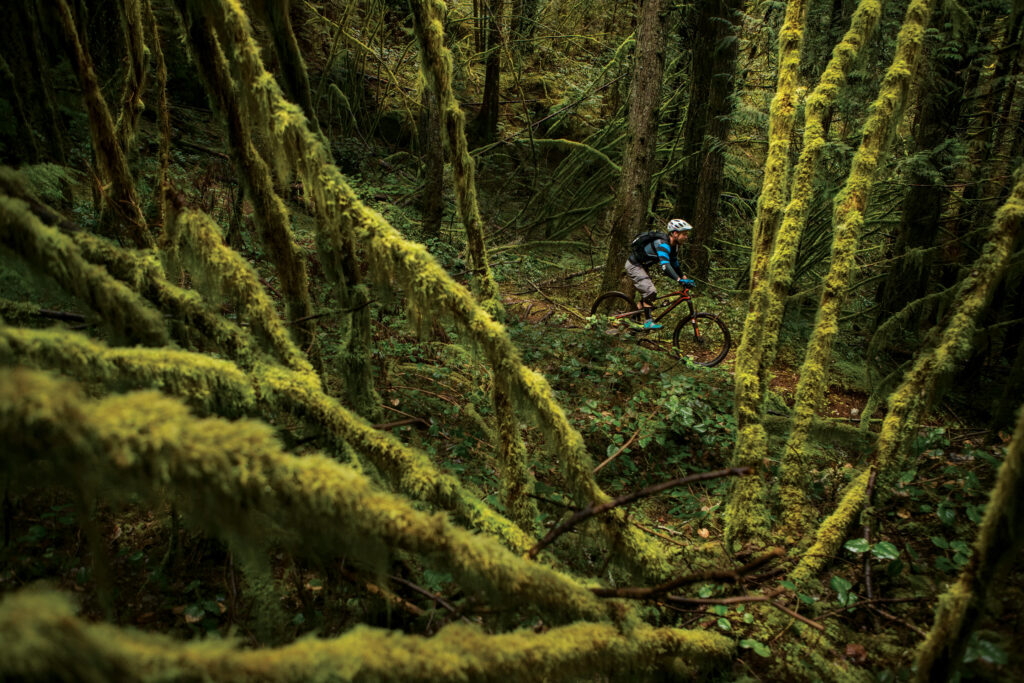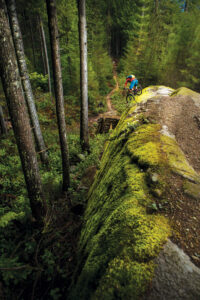
These athletes team up with gravity for breathtaking rides down BC’s biggest mountain peaks. Meet the trail builders and riders who help make BC the mountain biking mecca of North America (and the world).
The ground rushes toward you as you and your bike dodge trees and jump streams. By the end of the ride, you’ll have dropped nearly 5,000 ft (1,500 m) of elevation from the top of Whistler Mountain. With adrenalin coursing through your veins, it’s easy to see why the thrill is so addicting.
If you build it, they will ride
Mountain biking was launched into existence under the hot California sun on the dry, dusty hilltops of Marin County. Today, the International Mountain Biking Association ranks Canada as one of the top places in the world to shred the gnar. You can find rad spots to ride anywhere in the country, but BC, followed by Alberta, Ontario, and Quebec, leads the pack with the most trails and mountain bike tour operators.

“It’s the best feeling to see someone come down the trail and see how excited they are with what you’ve made,” says Stevens.
Elite biker Paul Stevens grew up in the United Kingdom with a love for biking and downhill racing. After seeing Canada’s mountain bike scene featured in magazines, he was determined to jump across the pond.
“I saved up to come over and fell in love with the place,” says Stevens. “BC’s the best place in the world for a mountain biker! There’s a huge network of trails at your doorstep anywhere in the Sea-to-Sky Corridor.”
The corridor snakes its way from Horseshoe Bay, just outside of Vancouver, and up past Whistler to the Pemberton Valley. Soaring mountain peaks, misty forests, and thundering waterfalls create the perfect obstacle course for bike-wielding outdoor junkies. Hundreds of mountain bike trails are a testament to BC’s strong cycling community.
“Bikers started going out to build the stuff they wanted to ride,” explains Stevens. “Now every town in the corridor from Vancouver to Pemberton has its own cycling association. These associations build and maintain the trails, but there are still people who go out and build for fun.”
Stevens is one of them. He and his friend Dave Anderson recently finished a trail on Blackcomb Mountain. “A few years of work was put into it,” laughs Stevens. “It honestly took hours and hours spent walking in the woods.”
Anderson got the idea one winter, so the following summer the two bikers went back and walked through the same zone. They marked their way down from the peak using flagging tape, picking their way through the forest around crevices and downed trees. In their mind’s eye, the two visualized where the tightest corners and the best jumps could go.
With the rough outline marked, Stevens, Anderson, and their friends began the work of clearing and building. Months rolled by and the trail took shape, zigzagging down the mountain past rock faces, through ravines, and over bridges. It was soon time to test it out.
“You have all these ideas about how it’ll feel, but you never know for sure until you ride it,” says Stevens. “I’d ridden little sections of it, but never the whole thing. When it was done, we did a big ride with everyone who helped us build the trail.”
For Stevens, the first trip down the trail he had built by hand was utterly breathtaking. Literally. The two bikers christened their work Micro Climate, and reviewers have called it an “instant Whistler classic.”
“It’s the best feeling to see someone come down the trail and see how excited they are with what you’ve made,” says Stevens.
Mountain biker lingo
Mountain bikers have their own vocabulary to describe the thrill. Here’s just a sampling.
| bunny hop | a trick where you use your legs and arms to jump and lift your bike over a small obstacle, such as rocks or a log |
| cadence | your pedalling rate |
| cornering | leaning into a corner to turn |
| dialed | when you, your bike, and your bike’s components are perfectly in sync |
| dropping | when you go next on a trail (you’ve been “snaked” if someone cuts you off) |
| berm | an embankment you encounter on a trail |
| give’r | go for it! |
| gnarl | difficult, technical trails, most common in the Pacific Northwest |
| kit | your outfit, from your cap down to your shoes |
| rock garden | parts of a trail covered in stones |

“You have to earn that descent and work hard to first get to the top.”
Oh Canada, our home and playful land
Christine Shandro recently rode Stevens’ trail. “It’s awesome!” she exclaims. “Mountain biking has a real sense of community and inclusiveness. These trail builders have been building trails for nothing. They just love the sport, and they’re in there working every weekend all day long, never expecting any accolades. They just truly love building rad trails.”
Christine and her husband, Andrew Shandro, are veterans of BC’s mountain biking scene. “I started when I was 17 back in the mid-1980s,” says Andrew. “We both grew up on the North Shore of Vancouver, with trails right in our backyard.”
“I never rode a bike as a young girl,” adds Christine. “I got started through Andrew. We were dating and he was doing a lot of racing. Actually, he bought me a bike on one of our first dates.”
Christine laughs as she recounts her first novice mountain bike race. “Some of the courses back in the day were really hard technically, going over different obstacles or down rocky steps,” she reminisces. “I was a beginner rider and I was nervous, but that first race was in a farmer’s field! It was muddy and completely docile, just basically flat dirt. It was pretty funny.”
A lot has changed since then. Christine became a pro elite mountain bike racer and a member of the mountain bike national team. Andrew racked up gold medals at the X-Games and is a four-time Canadian national champion in downhill mountain biking.
But one thing hasn’t changed: the passion that propels them down the mountain like gravity.
Find the flow
“It’s all about the feel,” says Andrew, “the speed, the creativity, how you interpret the trail, and how you interpret the terrain. I love the feel of it, the sound of your tires, and how you hit the corner fast or hit a jump …”
But before you can enjoy the ride down, you have to get to the summit. “I love that you have to earn it,” says Christine. “You have to earn that descent and work hard to first get up to the top. You also feel a sense of accomplishment when you ride something hard and you make it to the bottom in one piece. It’s fun to push yourself.”
For this power couple, the adrenalin rush even brings about an almost Zen-like moment of total presence. “When you’re riding, especially on more technical terrain, you have to focus,” says Andrew. “You can’t let your mind wander. You just need to focus on riding down the trail, not thinking about other things in life. And if you do start thinking about those other things, you crash!”
“I love … enjoying just the moment and not thinking of what else is going on,” says Christine. “You put it all behind you. When you look at it as a sport, it really gets you away from whatever—the city, the noise. There’s not a lot of crowds. Once you’re in the trail, you can go for a two-hour ride without seeing another person. It’s quiet; it’s beautiful.”
A family and friend affair
While mountain biking gives riders a chance to explore nature in all of its majestic solitude, for the Shandros it’s also the quintessential family outing.
“One of the biggest things for us is that it’s really fun and it’s something we can both do together,” says Christine. “We enjoy doing it with our friends, and both of our kids do it now. We can go out as a family.”
Bike parks have made mountain biking much more accessible for children who might not be so keen on hiking up a peak. And more and more of these parks are popping up across the country, introducing entire families to biking.
“Both of our kids grew up surrounded by bikes and seeing all these bikes in the garage,” adds Andrew. “Our son immediately took to it. There was no ‘Hey, we should go biking.’ He just latched on. And our daughter loves it when she’s got her friends with her; she’s very social.”

BC is known as one of the meccas of the mountain biking world.
State of the ride
“My background was cross-country, but my success was in downhilling,” explains Andrew. If you’re interested in mountain biking, those are just a sampling of the different styles available.
Cross-country
It’s the most popular form of mountain biking, and the most accessible to most skill levels. The average race is 20 to 30 km along unpaved paths.
Downhill
Bikers hike or drive to the top of a peak, then drop to the bottom at maximum speeds. You whiz through the forest so fast that some race courses only take a couple of minutes to complete.
Freeriding
From ramps to bridges to sudden drop-offs, it’s mountain biking with man-made obstacles in a bike park rather than on a mountain.
Dirt jumping
Like the name says, you jump mounds or ramps of dirt with the goal of staying airborne as long as possible. While floating across the sky, riders attempt various tricks and spins.
Downhill and freeriding are the varieties of choice for younger riders. Older riders like cross-country. But no matter the style you choose to try, Canada—and BC specifically—is the place to do it.
“The community is flourishing,” says Andrew. “BC is known as one of the meccas of mountain biking in the world. The Whistler bike park is the first park of its kind in the world. The amount and variety of terrain is what separates us from any other place.”
Getting into gear
There are many types of mountain bikes to choose from, so measure your height and the inside of your leg, and then take those numbers to a bike shop to find a ride that’s right for you. Mountain bikes are not the same as road bikes or BMX bikes; they’re made to withstand the rigours of exploring the slopes.
For peak performance, you’ll also want a helmet, gloves (some riders don’t wear them, but they’re recommended for beginners, who are more apt to take a tumble), tight-fitting cycling clothes, and a water bottle. For more information about choosing the right bike and protective gear, check out “All Thrills—No Spills”.
Most importantly? Bring with you a sense of openness, flexibility, and adventure.
- Try a jump or a sharp corner. It’s perfectly fine if you fail.
- Take a break when you feel tired. Enjoy the sights and smells of the mountain.
- Get off your bike and walk a part of the trail that makes you feel uncomfortable.
- Enjoy the feeling of playing in nature and being in the moment.
Mountain biking has evolved to become more inclusive, so don’t worry about whether you’re young enough, strong enough, or active enough. When the sport was first getting going, most of the trails were difficult and highly technical. Now, anyone can head out and find a ride that suits their level of experience.
“People are now building super-accessible trails for all riders of all levels,” says Christine. “We’ve ridden for 25 years, and now we see people of all ages wanting to ride. The trails have changed and some of them are a lot easier, so you’re seeing people with their wives or kids up there. There are a lot more people getting into the sport.”
Today’s the perfect time to take a jump. Literally.
A spectator sport
Bike races dot the country throughout the year. Here’s just a sample.
| BC Bike Race | July 5-13—seven-day journey through Powell River, Squamish, Whistler, and more |
| 2017 Canadian XCO Championships | July 22-23—Canmore, Alberta |
| Mont-Ste-Anne Mountain Bike World Cup | August 5-6—Mont-Ste-Anne, Quebec |
| Crankworx | August 11-20—Whistler, BC |
| 2017 Canadian Cyclo-cross Championships | October 28—Sherbrooke, Quebec |







